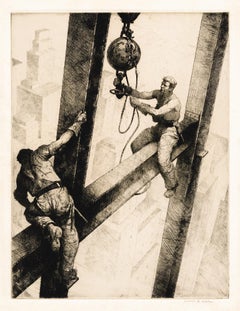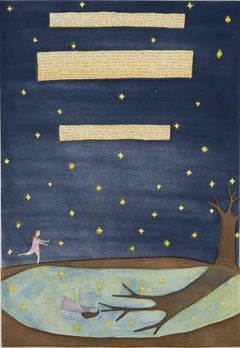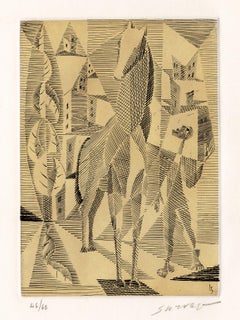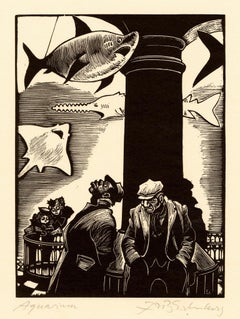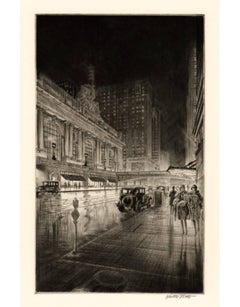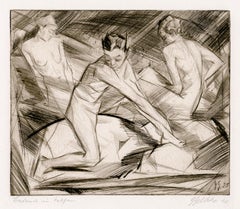Ifpda International Fine Print Dealers Association Prints and Multiples
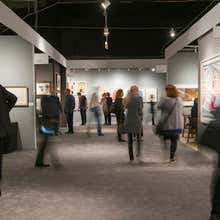
Launched in 1987, the International Fine Print Dealers Association has continually set the bar for quality and ethics while promoting prints as original works of art to generations of collectors, curators and art lovers. With over 160 members in 13 countries, the IFPDA is a worldwide community of leading dealers and editions publishers who represent the full spectrum of printmaking. Each year, the IFPDA hosts the IFPDA Print Fair in New York, the only major fair dedicated to fine-art prints.
1930s American Realist Ifpda International Fine Print Dealers Association Prints and Multiples
Etching
21st Century and Contemporary Contemporary Ifpda International Fine Print Dealers Association Prints and Multiples
Etching
1950s Surrealist Ifpda International Fine Print Dealers Association Prints and Multiples
Etching
1930s American Modern Ifpda International Fine Print Dealers Association Prints and Multiples
Woodcut
1920s American Impressionist Ifpda International Fine Print Dealers Association Prints and Multiples
Drypoint
1920s Expressionist Ifpda International Fine Print Dealers Association Prints and Multiples
Etching
1920s Art Deco Ifpda International Fine Print Dealers Association Prints and Multiples
Lithograph
19th Century Impressionist Ifpda International Fine Print Dealers Association Prints and Multiples
Drypoint, Etching
1940s American Modern Ifpda International Fine Print Dealers Association Prints and Multiples
Etching
Early 1900s Vienna Secession Ifpda International Fine Print Dealers Association Prints and Multiples
Woodcut
20th Century Contemporary Ifpda International Fine Print Dealers Association Prints and Multiples
Lithograph
Early 20th Century American Modern Ifpda International Fine Print Dealers Association Prints and Multiples
Watercolor
1920s Realist Ifpda International Fine Print Dealers Association Prints and Multiples
Engraving, Drypoint
1980s American Modern Ifpda International Fine Print Dealers Association Prints and Multiples
Monoprint
1850s Ifpda International Fine Print Dealers Association Prints and Multiples
Black and White
1940s American Realist Ifpda International Fine Print Dealers Association Prints and Multiples
Lithograph
16th Century Old Masters Ifpda International Fine Print Dealers Association Prints and Multiples
Engraving
1970s Abstract Ifpda International Fine Print Dealers Association Prints and Multiples
Lithograph
16th Century Old Masters Ifpda International Fine Print Dealers Association Prints and Multiples
Engraving
1890s French School Ifpda International Fine Print Dealers Association Prints and Multiples
Lithograph
17th Century Baroque Ifpda International Fine Print Dealers Association Prints and Multiples
Engraving
1940s American Modern Ifpda International Fine Print Dealers Association Prints and Multiples
Lithograph
Mid-20th Century Abstract Ifpda International Fine Print Dealers Association Prints and Multiples
Screen
1920s Showa Ifpda International Fine Print Dealers Association Prints and Multiples
Woodcut
1910s Ifpda International Fine Print Dealers Association Prints and Multiples
Woodcut, Drypoint
1980s Ifpda International Fine Print Dealers Association Prints and Multiples
Aquatint, Color
1980s Contemporary Ifpda International Fine Print Dealers Association Prints and Multiples
Mezzotint
1930s Modern Ifpda International Fine Print Dealers Association Prints and Multiples
Engraving
1910s American Modern Ifpda International Fine Print Dealers Association Prints and Multiples
Lithograph
1980s Abstract Geometric Ifpda International Fine Print Dealers Association Prints and Multiples
Screen
1920s Expressionist Ifpda International Fine Print Dealers Association Prints and Multiples
Woodcut
1910s American Modern Ifpda International Fine Print Dealers Association Prints and Multiples
Woodcut
1920s Post-Impressionist Ifpda International Fine Print Dealers Association Prints and Multiples
Monotype
1750s Old Masters Ifpda International Fine Print Dealers Association Prints and Multiples
Etching
1860s American Realist Ifpda International Fine Print Dealers Association Prints and Multiples
Engraving
21st Century and Contemporary Abstract Ifpda International Fine Print Dealers Association Prints and Multiples
Screen
1940s American Modern Ifpda International Fine Print Dealers Association Prints and Multiples
Woodcut
Late 20th Century Abstract Ifpda International Fine Print Dealers Association Prints and Multiples
Offset, Screen
1920s American Realist Ifpda International Fine Print Dealers Association Prints and Multiples
Aquatint
1930s American Modern Ifpda International Fine Print Dealers Association Prints and Multiples
Lithograph
1950s Modern Ifpda International Fine Print Dealers Association Prints and Multiples
Woodcut
2010s Photorealist Ifpda International Fine Print Dealers Association Prints and Multiples
Photographic Paper, Digital
16th Century Old Masters Ifpda International Fine Print Dealers Association Prints and Multiples
Engraving
1910s Ifpda International Fine Print Dealers Association Prints and Multiples
Drypoint, Etching
1940s Surrealist Ifpda International Fine Print Dealers Association Prints and Multiples
Drypoint
1920s Ifpda International Fine Print Dealers Association Prints and Multiples
Paper
1940s American Realist Ifpda International Fine Print Dealers Association Prints and Multiples
Drypoint
1920s Cubist Ifpda International Fine Print Dealers Association Prints and Multiples
Engraving
1940s Surrealist Ifpda International Fine Print Dealers Association Prints and Multiples
Engraving
1870s American Realist Ifpda International Fine Print Dealers Association Prints and Multiples
Woodcut
1920s American Impressionist Ifpda International Fine Print Dealers Association Prints and Multiples
Woodcut
1820s Realist Ifpda International Fine Print Dealers Association Prints and Multiples
Etching
1910s Modern Ifpda International Fine Print Dealers Association Prints and Multiples
Woodcut
1920s Modern Ifpda International Fine Print Dealers Association Prints and Multiples
Linocut
1970s Abstract Ifpda International Fine Print Dealers Association Prints and Multiples
Woodcut
21st Century and Contemporary Contemporary Ifpda International Fine Print Dealers Association Prints and Multiples
Lithograph
1850s Romantic Ifpda International Fine Print Dealers Association Prints and Multiples
Lithograph
15th Century and Earlier Old Masters Ifpda International Fine Print Dealers Association Prints and Multiples
Woodcut
1930s American Modern Ifpda International Fine Print Dealers Association Prints and Multiples
Etching, Aquatint
1980s Arte Povera Ifpda International Fine Print Dealers Association Prints and Multiples
Screen
Read More
Revisiting Robert Rauschenberg’s Creative Rebellion on His 100th Birthday
A planet-wide celebration feels fitting for an artist who saw connections everywhere: between paint and photography, art and life, self and surroundings.
Red Grooms’s 3D Tugboat Is a Chaotic, Comic Take on New York Life
The sculptural lithograph is part of the inimitable artist’s “Ruckus” series, now on view at the Brooklyn Museum.
Joan Mitchell’s Rare, Late-Career Diptych Buzzes with Life
Beneath the inky blackness, the painter’s irrepressible energy electrifies this pair of intaglio prints.
The 1stDibs Guide to Types of Abstract Art
Get to know the key movements and artists who have influenced visual culture for more than a century.
Romare Bearden’s Humanity Infuses His Bright, Bold Art
Through collage, painting and printmaking, the artist foregrounded Black life in America in revolutionary new ways.
Andy Warhol and Suzie Frankfurt’s ‘Wild Raspberries’ Cookbook Is an Artful, Fanciful Delight
This set of recipes and original prints might not make you a better chef. But it will make you smile.
Art Brings the Drama in These Intriguing 1stDibs 50 Spaces
The world’s top designers explain how they display art to elicit the natural (and supernatural) energy of home interiors.
Welcome (Back) to the Wild, Wonderful World of Walasse Ting
Americans are rediscovering the globe-trotting painter and poet, who was connected to all sorts of art movements across a long and varied career.
